Spatial Differentiation and Driving Factor Analysis of Urban Construction Land Change in County-Level City of Guangxi, China
Abstract
:1. Introduction
1.1. Background
1.2. Literature Review
1.3. Aim and Question
2. Research Design
2.1. Study Area: Guangxi
2.2. Research Methods
2.3. Index Selection
2.4. Research Steps
3. Results
3.1. Differentiation Analysis
3.2. Factor Analysis
3.3. Interaction Analysis
4. Discussion
4.1. Driving Mechanism
4.2. Policy Implications: Precision and Differentiation
5. Conclusions
Author Contributions
Funding
Informed Consent Statement
Data Availability Statement
Acknowledgments
Conflicts of Interest
References
- Wang, Y.F.; Zhao, F.F.; Cheng, L.; Yang, K. Framework for monitoring the conversion of cultivated land to construction land using SAR image time series. Remote Sens. Lett. 2015, 6, 794–803. [Google Scholar] [CrossRef]
- Noszczyk, T. A review of approaches to land use changes modeling. Hum. Ecol. Risk Assess. 2019, 25, 1377–1405. [Google Scholar] [CrossRef]
- United Nations Department of Economic and Social Affairs/Population Division III. World Urbanization Prospects: The 2009 Revision; United Nations: New York, NY, USA, 2010; Available online: https://www.ipcc.ch/apps/njlite/ar5wg2/njlite_download2.php?id=10148 (accessed on 18 March 2021).
- Wang, J.; Li, Y.R.; Wang, Q.Y.; Cheong, K.C. Urban-Rural Construction Land Replacement for More Sustainable Land Use and Regional Development in China: Policies and Practices. Land 2019, 8, 171. [Google Scholar] [CrossRef] [Green Version]
- Noszczyk, T. Land Use Change Monitoring as a Task of Local Government Administration in Poland. J. Ecol. Eng. 2018, 19, 170–176. [Google Scholar] [CrossRef]
- Wang, J.; Skidmore, M.; Wu, Q.; Wang, S. The impact of a tax cut reform on land finance revenue: Constrained by the binding target of construction land. J. Urban Aff. 2020. [Google Scholar] [CrossRef]
- Cao, Y.; Zhang, X.L.; Zhang, X.K.; Li, H. The incremental construction land differentiated management framework: The perspective of land quota trading in China. Land Use Policy 2020, 96, 104675. [Google Scholar] [CrossRef]
- Lu, S.H.; Wang, H. Distributive politics in China: Regional favouritism and expansion of construction land. Urban Stud. 2020, 57, 1600–1619. [Google Scholar] [CrossRef]
- Liu, T.; Liu, H.; Qi, Y.J. Construction land expansion and cultivated land protection in urbanizing China: Insights from national land surveys, 1996–2006. Habitat Int. 2015, 46, 13–22. [Google Scholar] [CrossRef]
- Cui, X.F.; Yang, S.; Zhang, G.H.; Liang, B.; Li, F. An Exploration of a Synthetic Construction Land Use Quality Evaluation Based on Economic-Social-Ecological Coupling Perspective: A Case Study in Major Chinese Cities. Int. J. Environ. Res. Public Health 2020, 17, 3663. [Google Scholar] [CrossRef]
- Huang, D.Q.; Lang, Y.; Liu, T. The Evolving Structure of Rural Construction Land in Urbanizing China: Case Study of Tai’an Prefecture. Land 2021, 10, 65. [Google Scholar] [CrossRef]
- Noszczyk, T.; Rutkowska, A.; Hernik, J. Exploring the land use changes in Eastern Poland: Statistics-based modeling. Hum. Ecol. Risk Assess. 2020, 26, 255–282. [Google Scholar] [CrossRef]
- Cegielska, K.; Noszczyk, T.; Kukulska, A.; Szylar, M.; Hernik, J.; Dixon-Gough, R.; Jombach, S.; Valanszki, I.; Kovacs, K.F. Land use and land cover changes in post-socialist countries: Some observations from Hungary and Poland. Land Use Policy 2018, 78, 1–18. [Google Scholar] [CrossRef]
- Li, Z.; Jiang, W.G.; Wang, W.J.; Lei, X.; Deng, Y. Exploring spatial-temporal change and gravity center movement of construction land in the Chang-Zhu-Tan urban agglomeration. J. Geogr. Sci. 2019, 29, 1363–1380. [Google Scholar] [CrossRef] [Green Version]
- Yao, Y.X.; Li, J.; Zhang, X.G.; Duan, P.; Li, S.; Xu, Q.L. Investigation on the Expansion of Urban Construction Land Use Based on the CART-CA Model. ISPRS Int. J. Geo-Inf. 2017, 6, 149. [Google Scholar] [CrossRef]
- Aliani, H.; Malmir, M.; Sourodi, M.; Kafaky, S.B. Change detection and prediction of urban land use changes by CA-Markov model (case study: Talesh County). Environ. Earth Sci. 2019, 78, 546. [Google Scholar] [CrossRef]
- Karimi, H.; Jafarnezhad, J.; Khaledi, J.; Ahmadi, P. Monitoring and prediction of land use/land cover changes using CA-Markov model: A case study of Ravansar County in Iran. Arab. J. Geosci. 2018, 11, 592. [Google Scholar] [CrossRef]
- Xiong, Y.; Chen, Y.; Peng, F.; Li, J.Z.; Yan, X.J. Analog simulation of urban construction land supply and demand in Chang-Zhu-Tan Urban Agglomeration based on land intensive use. J. Geogr. Sci. 2019, 29, 1346–1362. [Google Scholar] [CrossRef] [Green Version]
- Huang, R.J.; Nie, Y.J.; Duo, L.H.; Zhang, X.P.; Wu, Z.H.; Xiong, J.C. Construction land suitability assessment in rapid urbanizing cities for promoting the implementation of United Nations sustainable development goals: A case study of Nanchang, China. Environ. Sci. Pollut. Res. 2021, 28, 25650–25663. [Google Scholar] [CrossRef]
- Yan, Y.T.; Zhou, R.; Ye, X.Y.; Zhang, H.; Wang, X.J. Suitability Evaluation of Urban Construction Land Based on an Approach of Vertical-Horizontal Processes. ISPRS Int. J. Geo-Inf. 2018, 7, 198. [Google Scholar] [CrossRef] [Green Version]
- Cao, M.; Zhao, J.; Zhang, S. Research on The Suitability Evaluation of Construction Land in Southwest Mountainous Areas of China: A Case Study of Baoxing County, Sichuan Province, China. Appl. Ecol. Environ. Res. 2018, 16, 6567–6587. [Google Scholar] [CrossRef]
- Xu, K.; Kong, C.F.; Li, J.F.; Zhang, L.Q.; Wu, C.L. Suitability evaluation of urban construction land based on geo-environmental factors of Hangzhou, China. Comput. Geosci. 2011, 37, 992–1002. [Google Scholar] [CrossRef]
- Bozdag, A.; Yavuz, F.; Gunay, A.S. AHP and GIS based land suitability analysis for Cihanbeyli (Turkey) County. Environ. Earth Sci. 2016, 75, 813. [Google Scholar] [CrossRef]
- Ustaoglu, E.; Aydinoglu, A.C. Suitability evaluation of urban construction land in Pendik district of Istanbul, Turkey. Land Use Policy 2020, 99, 104783. [Google Scholar] [CrossRef]
- Zhang, X.R.; Fang, C.L.; Wang, Z.B.; Ma, H.T. Urban Construction Land Suitability Evaluation Based on Improved Multi-criteria Evaluation Based on GIS (MCE-GIS): Case of New Hefei City, China. Chin. Geogr. Sci. 2013, 23, 740–753. [Google Scholar] [CrossRef] [Green Version]
- Xie, H.L.; Zhu, Z.H.; Wang, B.H.; Liu, G.Y.; Zhai, Q.L. Does the Expansion of Urban Construction Land Promote Regional Economic Growth in China? Evidence from 108 Cities in the Yangtze River Economic Belt. Sustainability 2018, 10, 4073. [Google Scholar] [CrossRef] [Green Version]
- Wang, K.Q.; Li, G.X.; Liu, H.M. Porter effect test for construction land reduction. Land Use Policy 2021, 103, 105310. [Google Scholar] [CrossRef]
- Guo, L.Y.; Di, L.P.; Tian, Q. Detecting spatio-temporal changes of arable land and construction land in the Beijing-Tianjin corridor during 2000–2015. J. Geogr. Sci. 2019, 29, 702–718. [Google Scholar] [CrossRef] [Green Version]
- Aneseyee, A.B.; Noszczyk, T.; Soromessa, T.; Elias, E. The InVEST Habitat Quality Model Associated with Land Use/Cover Changes: A Qualitative Case Study of the Winike Watershed in the Omo-Gibe Basin, Southwest Ethiopia. Remote Sens. 2020, 12, 1103. [Google Scholar] [CrossRef] [Green Version]
- Aneseyee, A.B.; Elias, E.; Soromessa, T.; Feyisa, G.L. Land use/land cover change effect on soil erosion and sediment delivery in the Winike watershed, Omo Gibe Basin, Ethiopia. Sci. Total Environ. 2020, 728, 138776. [Google Scholar] [CrossRef]
- Aneseyee, A.B.; Soromessa, T.; Elias, E. The effect of land use/land cover changes on ecosystem services valuation of Winike watershed, Omo Gibe basin, Ethiopia. Hum. Ecol. Risk Assess. 2020, 26, 2608–2627. [Google Scholar] [CrossRef]
- Sadat, M.; Zoghi, M.; Malekmohammadi, B. Spatiotemporal modeling of urban land cover changes and carbon storage ecosystem services: Case study in Qaem Shahr County, Iran. Environ. Dev. Sustain. 2020, 22, 8135–8158. [Google Scholar] [CrossRef]
- Li, Y.N.; Cai, M.M.; Wu, K.Y.; Wei, J.C. Decoupling analysis of carbon emission from construction land in Shanghai. J. Clean. Prod. 2019, 210, 25–34. [Google Scholar] [CrossRef]
- Jin, W.F.; Zhou, C.S.; Li, S.J.; Zhang, G.J. Factors affecting newly increased construction land at different development stages: Evidence from 352 Chinese cities. Environ. Plan. B Urban Anal. City Sci. 2021, 48, 358–375. [Google Scholar] [CrossRef]
- Yu, H.S.; Song, G.; Li, T.; Liu, Y.J. Spatial Pattern Characteristics and Influencing Factors of Green Use Efficiency of Urban Construction Land in Jilin Province. Complexity 2020, 2020, 5637530. [Google Scholar] [CrossRef]
- Wang, H.; Qiao, L.; Tian, C.; Lin, Q.Q. Utilisation Efficiency of Construction Land in China’s Coastal Cities Based on Debt Level. Complexity 2020, 2020, 3428968. [Google Scholar] [CrossRef]
- Liu, Y.S.; Zhang, Z.W.; Zhou, Y. Efficiency of construction land allocation in China: An econometric analysis of panel data. Land Use Policy 2018, 74, 261–272. [Google Scholar] [CrossRef]
- Ye, Y.Y.; Zhang, H.G.; Liu, K.; Wu, Q.T. Research on the influence of site factors on the expansion of construction land in the Pearl River Delta, China: By using GIS and remote sensing. Int. J. Appl. Earth Obs. Geoinf. 2013, 21, 366–373. [Google Scholar] [CrossRef]
- Li, Z.Y.; Luan, W.X.; Zhang, Z.C.; Su, M. Relationship between urban construction land expansion and population/economic growth in Liaoning Province, China. Land Use Policy 2020, 99, 105022. [Google Scholar] [CrossRef]
- Zhou, L.; Yuan, B.; Mu, H.W.; Dang, X.W.; Wang, S.H. Coupling relationship between construction land expansion and PM2.5 in China. Environ. Sci. Pollut. Res. 2021. [Google Scholar] [CrossRef]
- Cai, E.X.; Liu, Y.L.; Li, J.W.; Chen, W.Q. Spatiotemporal Characteristics of Urban-Rural Construction Land Transition and Rural-Urban Migrants in Rapid-Urbanization Areas of Central China. J. Urban Plan. Dev. 2020, 146, 05019023. [Google Scholar] [CrossRef]
- Li, M.; Shi, Y.Y.; Duan, W.K.; Chen, A.Q.; Wang, N.; Hao, J.M. Spatiotemporal Decoupling of Population, Economy and Construction Land Changes in Hebei Province. Sustainability 2019, 11, 6794. [Google Scholar] [CrossRef] [Green Version]
- Yang, Z.W.; Chen, Y.B.; Qian, Q.L.; Wu, Z.F.; Zheng, Z.H.; Huang, Q.Y. The coupling relationship between construction land expansion and high-temperature area expansion in China’s three major urban agglomerations. Int. J. Remote Sens. 2019, 40, 6680–6699. [Google Scholar] [CrossRef]
- He, Q.S.; Tan, S.K.; Yin, C.H.; Zhou, M. Collaborative optimization of rural residential land consolidation and urban construction land expansion: A case study of Huangpi in Wuhan, China. Comput. Environ. Urban Syst. 2019, 74, 218–228. [Google Scholar] [CrossRef]
- Zhu, B.S.; Bi, F. Research on Ecological Planning Method of Urban Construction Land Based on Comprehensive Benefits. Fresenius Environ. Bull. 2021, 30, 465–473. [Google Scholar]
- Zhu, J.; Tang, W.C. Conflict and compromise in planning decision-making: How does a Chinese local government negotiate its construction land quota with higher-level governments? Environ. Urban. 2018, 30, 155–174. [Google Scholar] [CrossRef] [Green Version]
- Tang, Y.; Mason, R.J.; Sun, P. Interest distribution in the process of coordination of urban and rural construction land in China. Habitat Int. 2012, 36, 388–395. [Google Scholar] [CrossRef]
- Zhou, Y.; Huang, X.J.; Zhong, T.Y.; Chen, Y.; Yang, H.; Chen, Z.G.; Xu, G.L.; Niu, L.D.; Li, H.H. Can annual land use plan control and regulate construction land growth in China? Land Use Policy 2020, 99, 105026. [Google Scholar] [CrossRef]
- Zhou, Y.; Huang, X.J.; Chen, Y.; Zhong, T.Y.; Xu, G.L.; He, J.L.; Xu, Y.T.; Meng, H. The effect of land use planning (2006–2020) on construction land growth in China. Cities 2017, 68, 37–47. [Google Scholar] [CrossRef]
- Liu, H.P.; Zhang, Y.X.; Zhang, X.P. Using the RS Method to Analyse Construction Land Changes in Tongren during 2002 and 2016. Pol. J. Environ. Stud. 2019, 28, 1277–1286. [Google Scholar] [CrossRef]
- Chen, G.B. GIS method and its application for harmonious evaluation of urban construction land and geological environment. Arab. J. Geosci. 2019, 12, 600. [Google Scholar] [CrossRef]
- Jiang, M.; Xin, L.J.; Li, X.B.; Tan, M.H. Spatiotemporal Variation of China’s State-Owned Construction Land Supply from 2003 to 2014. Sustainability 2016, 8, 1137. [Google Scholar] [CrossRef] [Green Version]
- Shi, Y.S.; Wu, J.; Shi, S.Z. Study of the Simulated Expansion Boundary of Construction Land in Shanghai Based on a SLEUTH Model. Sustainability 2017, 9, 876. [Google Scholar] [CrossRef] [Green Version]
- Zheng, Q.; Wang, K.; Huang, L.Y.; Zheng, Q.M.; Abubakar, G.A. Monitoring the Different Types of Urban Construction Land Expansion (UCLE) in China’s Port City: A Case Study of Ningbo’s Central City. Sustainability 2017, 9, 2374. [Google Scholar] [CrossRef] [Green Version]
- Cao, Y.G.; Bai, Z.K.; Zhou, W.; Ai, G. Gradient Analysis of Urban Construction Land Expansion in the Chongqing Urban Area of China. J. Urban Plan. Dev. 2015, 141, 05014009. [Google Scholar] [CrossRef] [Green Version]
- Zhang, J.J.; Su, F.Z. Spatial Pattern of Construction Land Distribution in Bays along the Coast of Vietnam. ISPRS Int. J. Geo-Inf. 2020, 9, 707. [Google Scholar] [CrossRef]
- Cai, F.F.; Pu, L.J.; Zhu, M. Assessment Framework and Decision-Support System for Consolidating Urban-Rural Construction Land in Coastal China. Sustainability 2014, 6, 7689–7709. [Google Scholar] [CrossRef] [Green Version]
- Wang, Z.B.; Fang, C.L.; Zhang, X.R. Spatial expansion and potential of construction land use in the Yangtze River Delta. J. Geogr. Sci. 2015, 25, 851–864. [Google Scholar] [CrossRef] [Green Version]
- Cao, Y.G. Forces Driving Changes in Urban Construction Land of Urban Agglomerations in China. J. Urban Plan. Dev. 2015, 141, 05014011. [Google Scholar] [CrossRef]
- Li, J.T.; Sun, Z.F. Urban Function Orientation Based on Spatiotemporal Differences and Driving Factors of Urban Construction Land. J. Urban Plan. Dev. 2020, 146, 05020011. [Google Scholar] [CrossRef]
- Li, Y.R.; Yi, L.; Karacsonyi, D.; Liu, Z.J.; Wang, Y.S.; Wang, J.Y. Spatio-temporal pattern and driving forces of construction land change in a poverty-stricken county of China and implications for poverty-alleviation-oriented land use policies. Land Use Policy 2020, 91, 104267. [Google Scholar] [CrossRef]
- Huang, H.; Zhou, Y.; Qian, M.J.; Zeng, Z.Q. Land Use Transition and Driving Forces in Chinese Loess Plateau: A Case Study from Pu County, Shanxi Province. Land 2021, 10, 67. [Google Scholar] [CrossRef]
- Xie, W.H.; Jin, W.F.; Chen, K.R.; Wu, J.L.; Zhou, C.S. Land Use Transition and Its Influencing Factors in Poverty-Stricken Mountainous Areas of Sangzhi County, China. Sustainability 2019, 11, 4915. [Google Scholar] [CrossRef] [Green Version]
- Zhu, Z.Q.; Liu, L.M.; Chen, Z.T.; Zhang, J.L.; Verburg, P.H. Land-use change simulation and assessment of driving factors in the loess hilly region-a case study as Pengyang County. Environ. Monit. Assess. 2010, 164, 133–142. [Google Scholar] [CrossRef]
- Hu, Y.F.; Batunacun, Z.L.; Zhuang, D.F. Assessment of Land-Use and Land-Cover Change in Guangxi, China. Sci. Rep. 2019, 9, 2189. [Google Scholar] [CrossRef] [Green Version]
- Dang, L.J.; Xu, Y.; Tang, Q. The pattern of available construction land along the Xijiang River in Guangxi, China. Land Use Policy 2015, 42, 102–112. [Google Scholar] [CrossRef]
- Chen, T.T.; Peng, L.; Liu, S.Q.; Wang, Q. Land cover change in different altitudes of Guizhou-Guangxi karst mountain area, China: Patterns and drivers. J. Mt. Sci. 2017, 14, 1873–1888. [Google Scholar] [CrossRef]
- Wang, J.F.; Li, X.H.; Christakos, G.; Liao, Y.L.; Zhang, T.; Gu, X.; Zheng, X.Y. Geographical detectors-based health risk assessment and its application in the neural tube defects study of the Heshun region, China. Int. J. Geogr. Inf. Sci. 2010, 24, 107–127. [Google Scholar] [CrossRef]
- Wang, J.F.; Xu, C.D. Geodetector: Principle and prospective. Acta Geogr. Sin. 2017, 72, 116–134. [Google Scholar]
- Liu, C.L.; Li, W.L.; Zhu, G.F.; Zhou, H.K.; Yan, H.P.; Xue, P.F. Land use/land cover changes and their driving factors in the Northeastern Tibetan Plateau based on Geographical Detectors and Google Earth Engine: A case study in Gannan Prefecture. Remote Sens. 2020, 12, 3139. [Google Scholar] [CrossRef]
- Zhang, H.W.; Wang, Z.Q.; Yang, B.; Chai, J.; Wei, C. Spatial—Temporal characteristics of illegal land use and its driving factors in China from 2004 to 2017. Int. J. Environ. Res. Public Health 2021, 18, 1336. [Google Scholar] [CrossRef]
- Zhu, M.Q.; Zhuang, D.C.; Zhang, H.X.; Wen, J.Q. Research on spatial differentiation and influencing factors of rural land use functions in the counties of Guangdong province. China Land Sci. 2021, 57, 79–87. [Google Scholar]
- Wang, J.F.; Hu, Y. Environmental health risk detection with GeogDetector. Environ. Model. Softw. 2012, 33, 114–115. [Google Scholar] [CrossRef]
- Wu, W.; Huang, C.P.; Zhano, X.J.; Hu, X.Y.; Wang, N. Spatial expansion characteristics and mechanism of urban land use in different modes: A case study of Ganzhou. Urban Dev. Stud. 2018, 25, 1–6. [Google Scholar]
- Qu, Y.B.; Jiang, G.H.; Tian, Y.Y.; Shang, R.; Wei, S.W.; Li, Y.L. Urban—Rural construction land Transition (URCLT) in Shandong Province of China: Feature’s measurement and mechanism exploration. Habitat Int. 2019, 86, 101–115. [Google Scholar] [CrossRef]
- Zhao, X.F.; Liu, M.L.; Wang, B.Y. Spatio-Temporal disparity of urban construction land and its impact factors in China based on Geodetector. China Land Sci. 2018, 32, 29–35. [Google Scholar]
- Liu, Y.W.; Cao, X.S.; Li, T. Identifying driving forces of built-up land expansion based on the geographical detector: A case study of Pearl River Delta urban agglomeration. Int. J. Environ. Res. Public Health 2020, 17, 1759. [Google Scholar] [CrossRef] [Green Version]
- Guan, X.Y.; Wang, S.L.; Gao, Z.Y.; Lv, Y.; Fu, X.J. Spatio-temporal variability of soil salinity and its relationship with the depth to groundwater in salinization irrigation district. Acta Ecol. Sin. 2012, 32, 198–206. [Google Scholar]
- Zhang, R.F. Theory and Application of Spatial Variability; Science Press: Beijing, China, 2005; pp. 13–14. [Google Scholar]
- Ruan, B.Q.; Xu, F.R.; Jiang, R.F. Analysis on spatial and temporal variability of groundwater level based on spherical sampling model. J. Hydraul. Eng. 2008, 39, 573–579. [Google Scholar]
- Liu, X.N.; Huang, F.; Wang, P. Spatial Analysis Principle and Method of GIS; Science Press: Beijing, China, 2008; pp. 199–206. [Google Scholar]
- Miyamoto, S.; Chacon, A.; Hossain, M.; Martinez, L. Soil salinity of urban turf areas irrigated with saline water I. Spatial variability. Landsc. Urban Plan. 2005, 71, 233–241. [Google Scholar]
- She, D.L.; Shao, M.A.; Yu, S.G. Spatial Variability of Soil Water Content on a Cropland-grassland Mixed Slope Land in the Loess Plateau, China. Trans. Chin. Soc. Agric. Mach. 2010, 41, 57–63. [Google Scholar]
- Cai, W.J.; Tu, F.Y. Spatiotemporal characteristics and driving forces of construction land expansion in Yangtze River economic belt, China. PLoS ONE 2020, 15, e0227299. [Google Scholar] [CrossRef] [PubMed]
- Wang, X.G.; Su, F.Z.; Zhang, J.J.; Cheng, F.; Hu, W.Q.; Ding, Z. Construction land sprawl and reclamation in the Johor River Estuary of Malaysia since 1973. Ocean Coast. Manag. 2019, 171, 87–95. [Google Scholar] [CrossRef]
- Wang, X.F.; Xiao, F.Y.; Zhang, Y.; Yin, L.C.; Lesi, M.C.; Guo, B.; Zhao, Y.H. Thirty-year expansion of construction land in Xi’an: Spatial pattern and potential driving factors. Geol. J. 2018, 53, 309–321. [Google Scholar] [CrossRef]
- Liu, Y.L.; Luo, T.; Liu, Z.Q.; Kong, X.S.; Li, J.W.; Tan, R.H. A comparative analysis of urban and rural construction land use change and driving forces: Implications for urban-rural coordination development in Wuhan, Central China. Habitat Int. 2015, 47, 113–125. [Google Scholar] [CrossRef]
- Jin, W.F.; Zhou, C.S.; Zhang, G.J. Characteristics of state-owned construction land supply in Chinese cities by development stage and industry. Land Use Policy 2020, 96, 104630. [Google Scholar] [CrossRef]
- Cao, Y.H.; Liu, M.Y.; Cao, Y.D.; Chen, C.; Zhang, D.P. Change pattern and driving mechanism of construction land in China’s undertaking industrial transfer demonstration area: Taking the Wanjiang City Belt along the Yangtze River as an Example. Earth Sci. Res. J. 2020, 24, 215–223. [Google Scholar] [CrossRef]
- Li, H.Z.; Yin, F.; Li, J.L. China’s Construction Land Expansion and Economic Growth: A Capital-output Ratio Based Analysis. China World Econ. 2008, 16, 46–62. [Google Scholar] [CrossRef]
- Tan, R.; Wang, R.Y.; Heerink, N. Liberalizing rural-to-urban construction land transfers in China: Distribution effects. China Econ. Rev. 2020, 60, 101147. [Google Scholar] [CrossRef]
- Fang, L.; Tian, C.H. Construction land quotas as a tool for managing urban expansion. Landsc. Urban Plan. 2020, 195, 103727. [Google Scholar] [CrossRef]
- Li, Y.J.; Kong, X.S.; Zhu, Z.Q. Multiscale analysis of the correlation patterns between the urban population and construction land in China. Sustain. Cities Soc. 2020, 61, 102326. [Google Scholar] [CrossRef]
- Zhou, Q.F.; Wu, X.Q.; Zhang, X.; Song, Y. Investigating the Spatiotemporal Disparity and Influencing Factors of Urban Construction Land Utilization Efficiency: Empirical Evidence from Panel Data of China. Adv. Civil Eng. 2021, 2021, 1613978. [Google Scholar] [CrossRef]
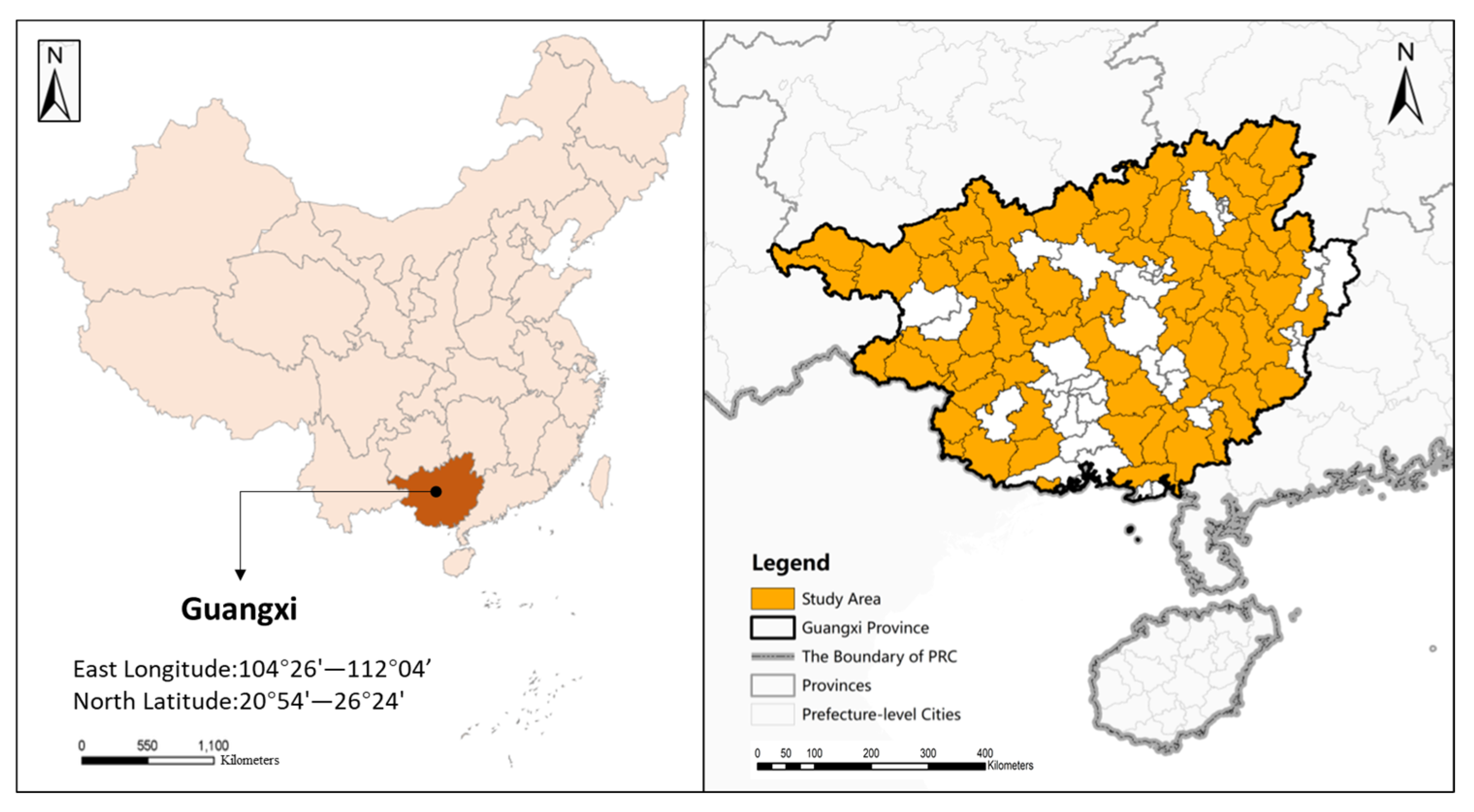
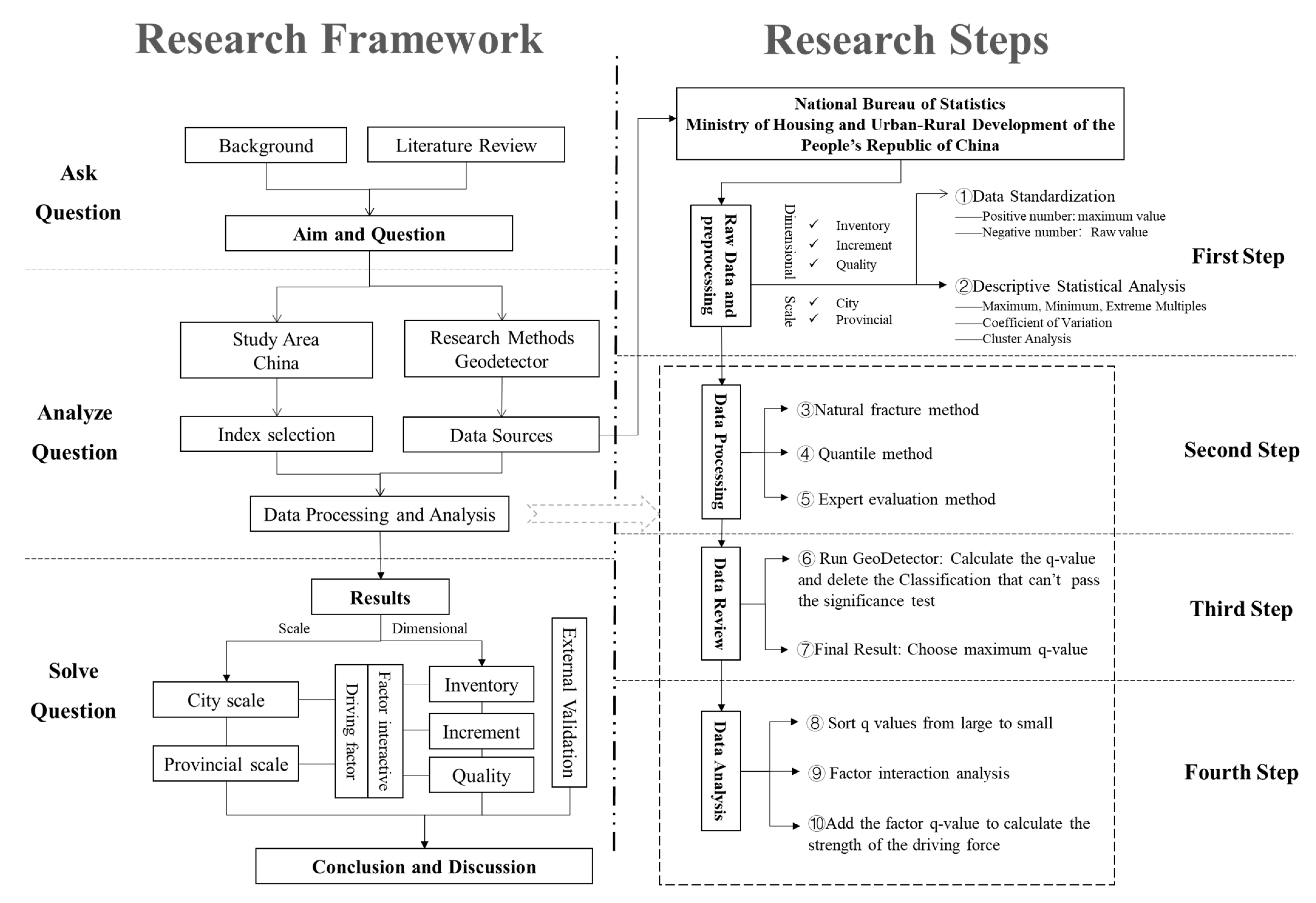

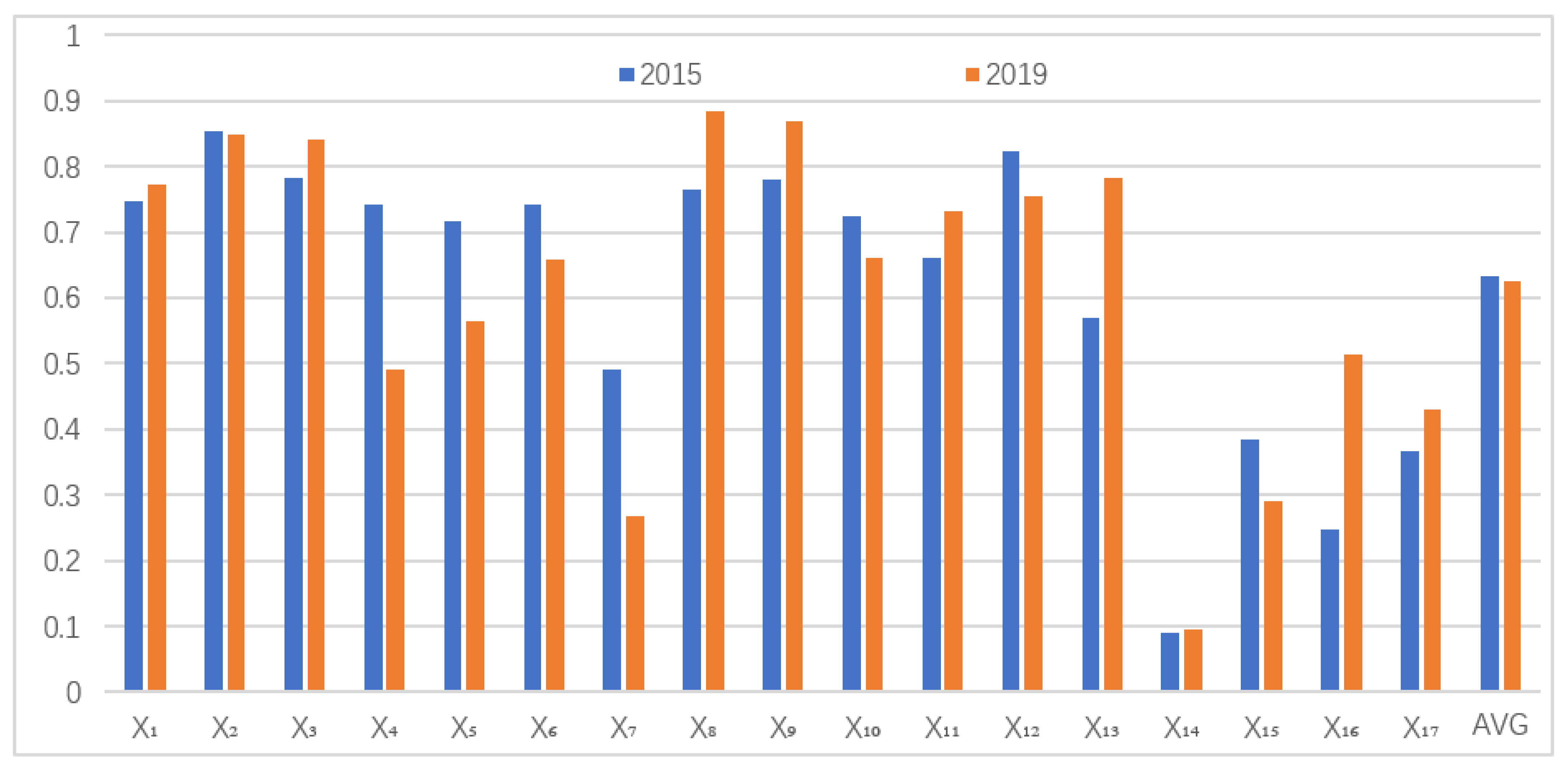
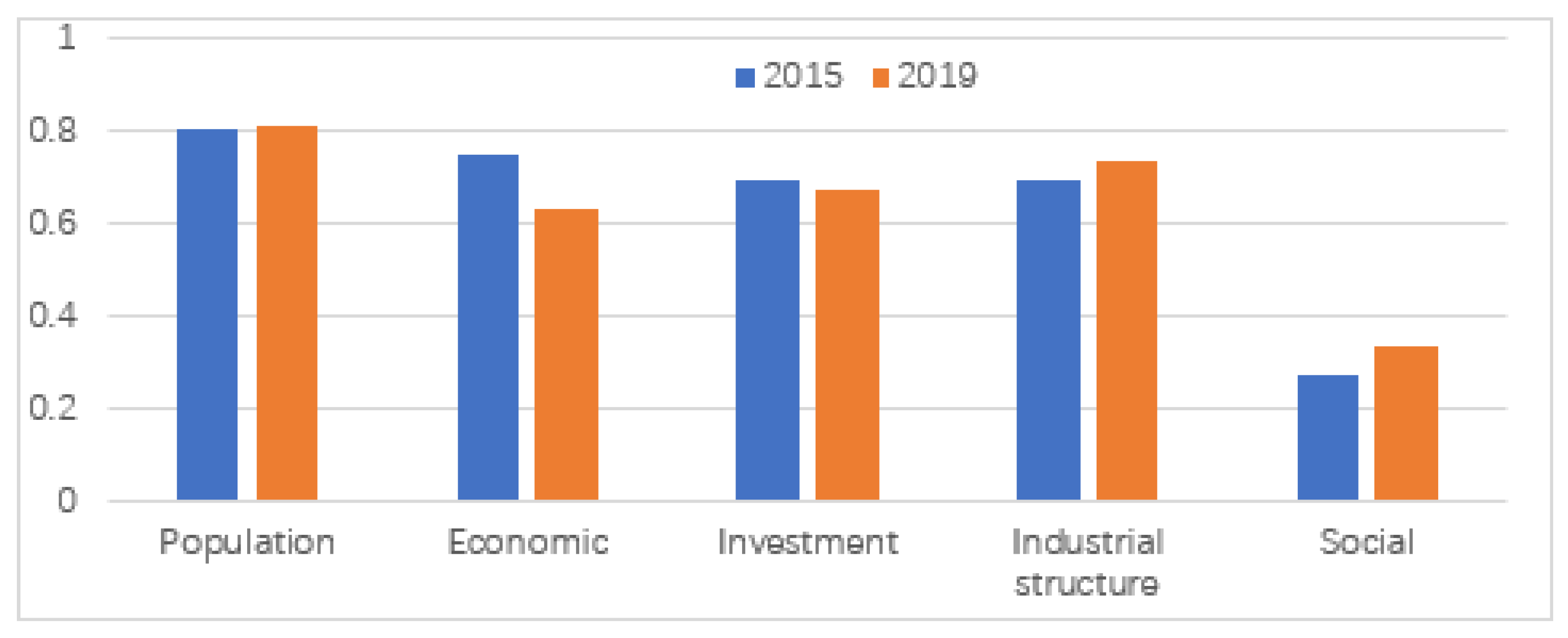

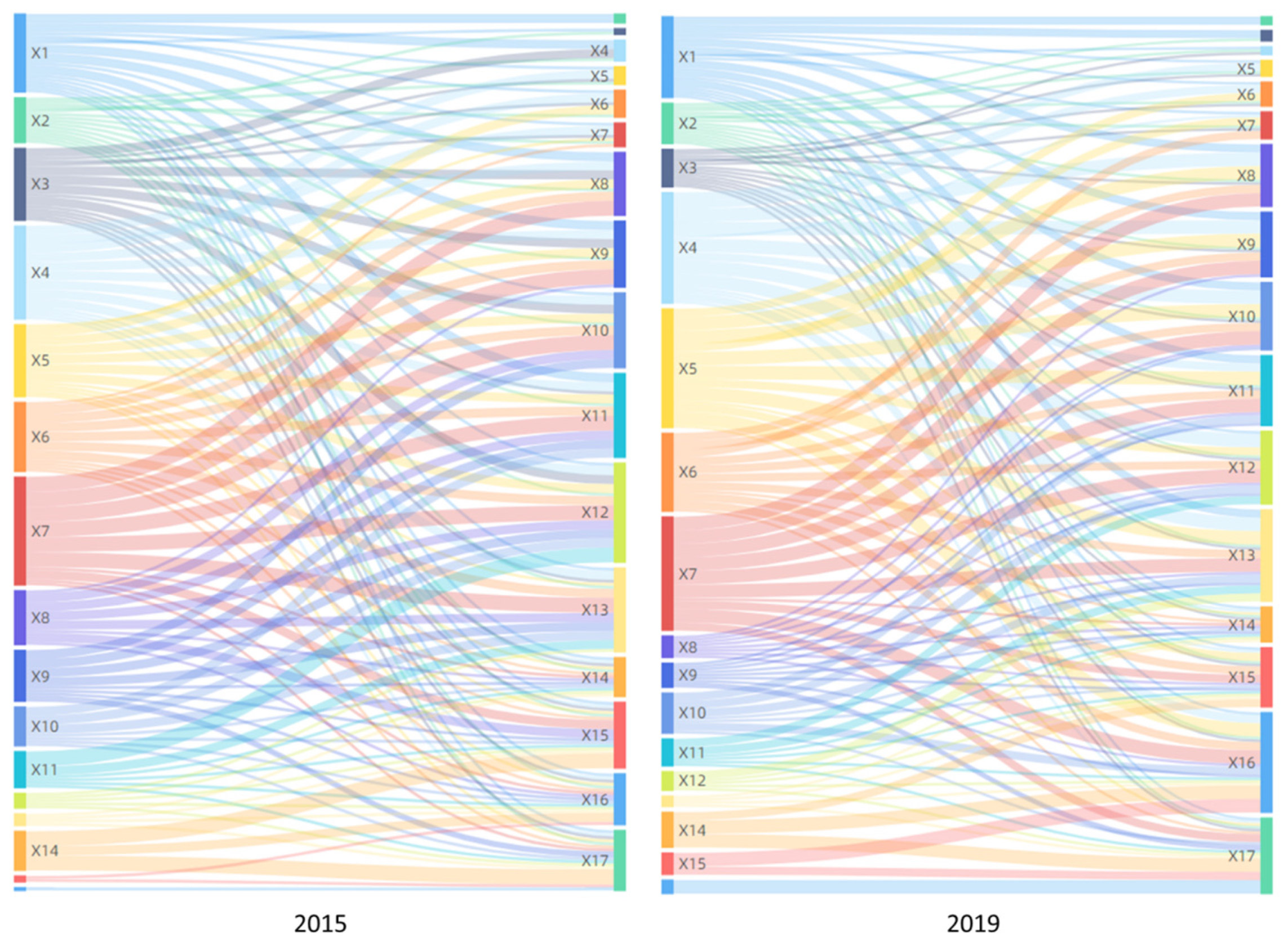
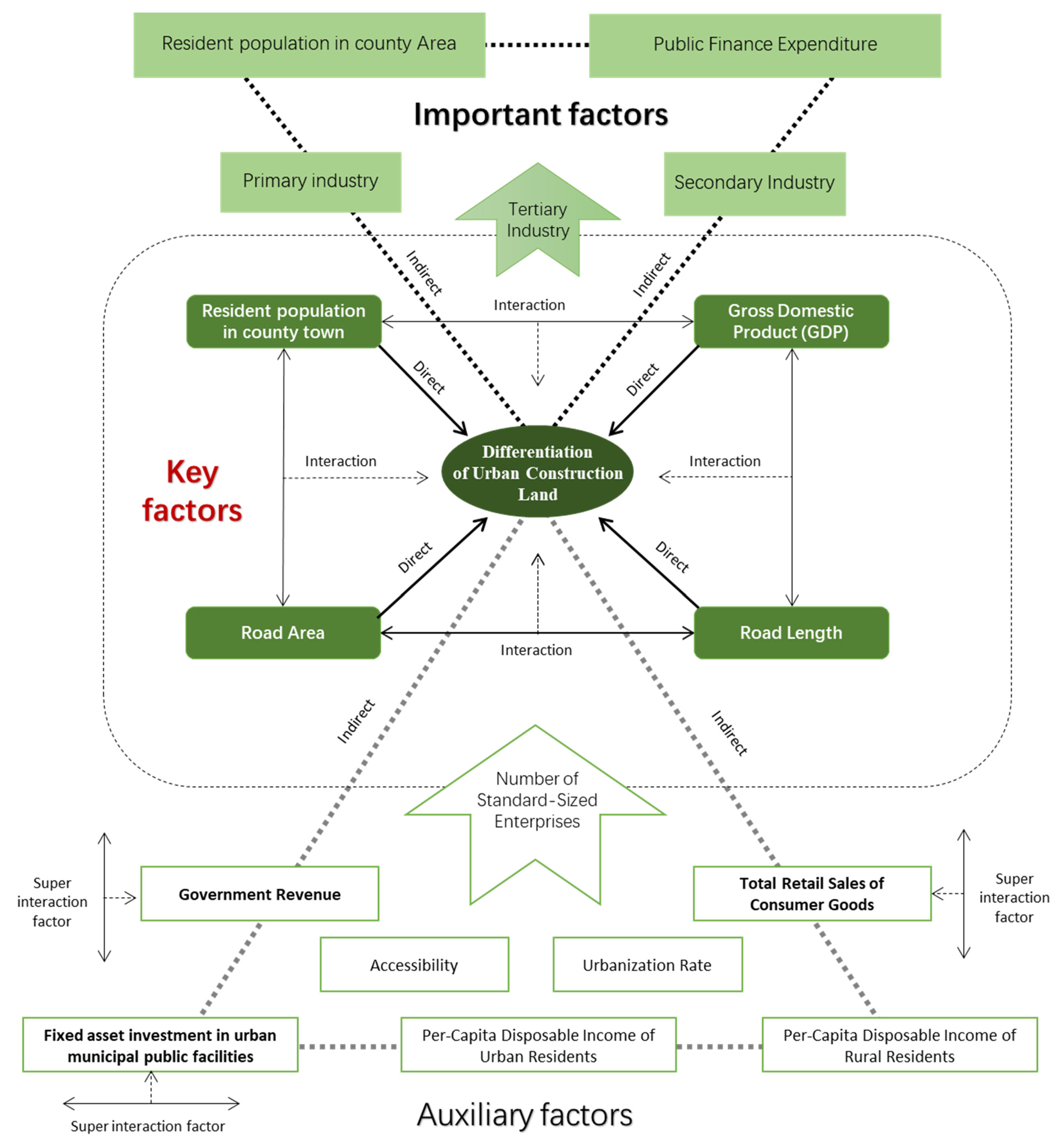
| Graphical Representation | Description | Interaction |
|---|---|---|
 | q( ∩ ) < Min(q(), q()) | Weaken, nonlinear |
 | Min(q(), q()) < q( ∩ ) < Max(q()), q()) | Weaken, uni- |
 | q( ∩ ) > Max(q(), q()) | Enhance, bi- |
 | q( ∩ ) = q() + q() | Independent |
 | q( ∩ ) > q() + q() | Enhance, nonlinear |
 Min(q(), q())
Min(q(), q())  Max(q(), q())
Max(q(), q())  q() + q()
q() + q()  q(∩). Originate: http://geodetector.cn/, accessed on 7 April 2021.
q(∩). Originate: http://geodetector.cn/, accessed on 7 April 2021.| Variable | Index | Code | Driving Force | Data Sources |
|---|---|---|---|---|
| Urban construction land area in 2019 | —— | Guangxi Construction Yearbook | ||
| Urban construction land area in 2015 | ||||
| Resident population in county area | Population driving force | |||
| Resident population in county town | ||||
| Gross domestic product (GDP) | Economic driving force | Guangxi Statistical Yearbook and County Statistical Bulletin | ||
| Government revenue | ||||
| Total retail sales of consumer soods | ||||
| Public finance expenditure | Investment driving force | |||
| Fixed asset investment in urban municipal public facilities | Guangxi Construction Yearbook | |||
| Road length | ||||
| Road area | ||||
| Primary industry | Industrial structure driving force | Guangxi Statistical Yearbook and County Statistical Bulletin | ||
| Secondary industry | ||||
| Tertiary industry | ||||
| Number of standard-sized enterprises | ||||
| Per-Capita disposable income of urban residents | Social driving force | |||
| Per-Capita disposable income of rural residents | ||||
| Urbanization rate | ||||
| Accessibility | Guangxi Traffic Map |
| Index | 2015 | 2019 | Change |
|---|---|---|---|
| Max | 29.93 | 37.38 | 16.48 |
| Min | 1.08 | 1.42 | −2.45 |
| Max–Min | 28.85 | 35.96 | 18.93 |
| Max/Min | 27.71 | 26.32 | -- |
| Average | 9.76 | 11.74 | 1.98 |
| Standard Deviation | 6.77 | 8.44 | 2.58 |
| Coefficient of Variation (CV) | 0.69 | 0.74 | 1.30 |
| 2015 | 2019 | |||
|---|---|---|---|---|
| Interaction Detector | Enhancement Effect | Interaction Detector | Enhancement Effect | |
| Max | 0.99 | 0.39 | 0.98 | 0.64 |
| Min | 0.09 | 0.01 | 0.09 | 0.01 |
| Median | 0.87 | 0.12 | 0.89 | 0.12 |
| Mode | 0.94 | 0.12 | 0.93 | 0.10 |
| Max–Min | 0.90 | 0.38 | 0.89 | 0.63 |
| Max/Min | 10.96 | 39.11 | 10.91 | 64.33 |
| Average | 0.84 | 0.13 | 0.85 | 0.17 |
| Gini Coefficient | 0.54 | 0.68 | 0.54 | 0.71 |
Publisher’s Note: MDPI stays neutral with regard to jurisdictional claims in published maps and institutional affiliations. |
© 2021 by the authors. Licensee MDPI, Basel, Switzerland. This article is an open access article distributed under the terms and conditions of the Creative Commons Attribution (CC BY) license (https://creativecommons.org/licenses/by/4.0/).
Share and Cite
Ouyang, D.; Zhu, X.; Liu, X.; He, R.; Wan, Q. Spatial Differentiation and Driving Factor Analysis of Urban Construction Land Change in County-Level City of Guangxi, China. Land 2021, 10, 691. https://doi.org/10.3390/land10070691
Ouyang D, Zhu X, Liu X, He R, Wan Q. Spatial Differentiation and Driving Factor Analysis of Urban Construction Land Change in County-Level City of Guangxi, China. Land. 2021; 10(7):691. https://doi.org/10.3390/land10070691
Chicago/Turabian StyleOuyang, Dong, Xigang Zhu, Xingguang Liu, Renfei He, and Qian Wan. 2021. "Spatial Differentiation and Driving Factor Analysis of Urban Construction Land Change in County-Level City of Guangxi, China" Land 10, no. 7: 691. https://doi.org/10.3390/land10070691
APA StyleOuyang, D., Zhu, X., Liu, X., He, R., & Wan, Q. (2021). Spatial Differentiation and Driving Factor Analysis of Urban Construction Land Change in County-Level City of Guangxi, China. Land, 10(7), 691. https://doi.org/10.3390/land10070691





